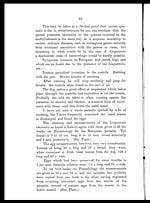Medicine - Veterinary > Civil Veterinary Departments > Indian Civil Veterinary Department memoirs > No. 2 - Collected notes
(244) [Page 61]
Download files
Individual page:
Thumbnail gallery: Grid view | List view
![(81) [Page 61] -](https://deriv.nls.uk/dcn17/7551/75512720.17.jpg)
LINGUATULA TÆNIOIDES.
BY
S. H. GAIGER, I.C.V.D.,
Punjab Veterinary College Laboratory.
THE extraordinary prevalence of this parasite amongst
pariah dogs in India has only been noticed during the last
six months.
Several cases of excessive hæmorrhage from the nostrils
of European dogs were met with and the absence of the
Hæmopis sanguisuga noted. The fæces were examined and
the eggs of the Anchylostomum trigonocephalum were in
most cases present. The patients were treated for anchylos-
tomiasis, but the periodical epistaxis continued.
It was then that it occurred to me to search in pariah
dogs for the Linguatula tænioides. The owners of the epis-
taxis patients would not allow a post-mortem examination.
Up to the present time over fifty pariah dogs have been
destroyed and the meati of the turbinated bones examined,
and in nearly every dog the Linguatula has been found.
From one to six is the usual number present in each dog.
I am very disinclined to attribute epistaxis in European
dogs to the parasite.
It may be from this cause in one or two isolated cases,
but in by far the greater number of cases it can be put down
to the Anchylostomum trigonocephalum which is present in
almost every dog examined, sometimes only one or two being
present and sometimes large numbers.
When many are present, the dog's condition is generally
very poor. I have never seen a case of epistaxis in pariah
dogs yet, though for several years many have been kept for
experimental inoculations, and on post-mortem examination
anchylostomes have very commonly been found, and recently
the Linguatula also.
Set display mode to: Large image | Zoom image | Transcription
Images and transcriptions on this page, including medium image downloads, may be used under the Creative Commons Attribution 4.0 International Licence unless otherwise stated. ![]()
| India Papers > Medicine - Veterinary > Civil Veterinary Departments > Indian Civil Veterinary Department memoirs > Collected notes > (244) [Page 61] |
|---|
| Permanent URL | https://digital.nls.uk/75512718 |
|---|
| Shelfmark | IP/RA.10. |
|---|---|
| Additional NLS resources: | |




